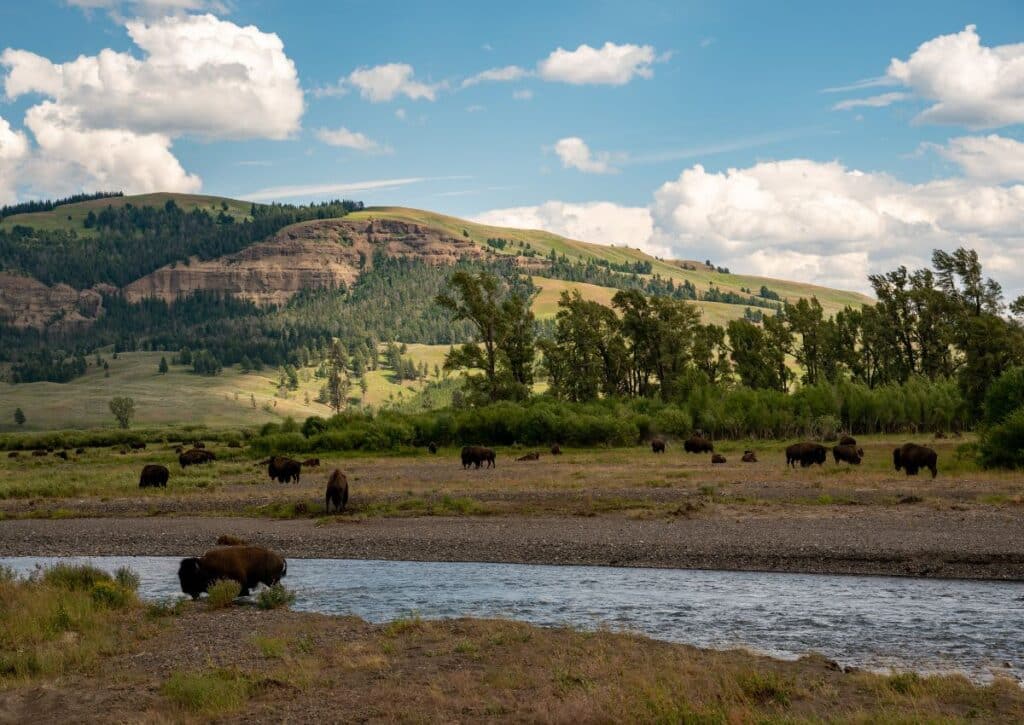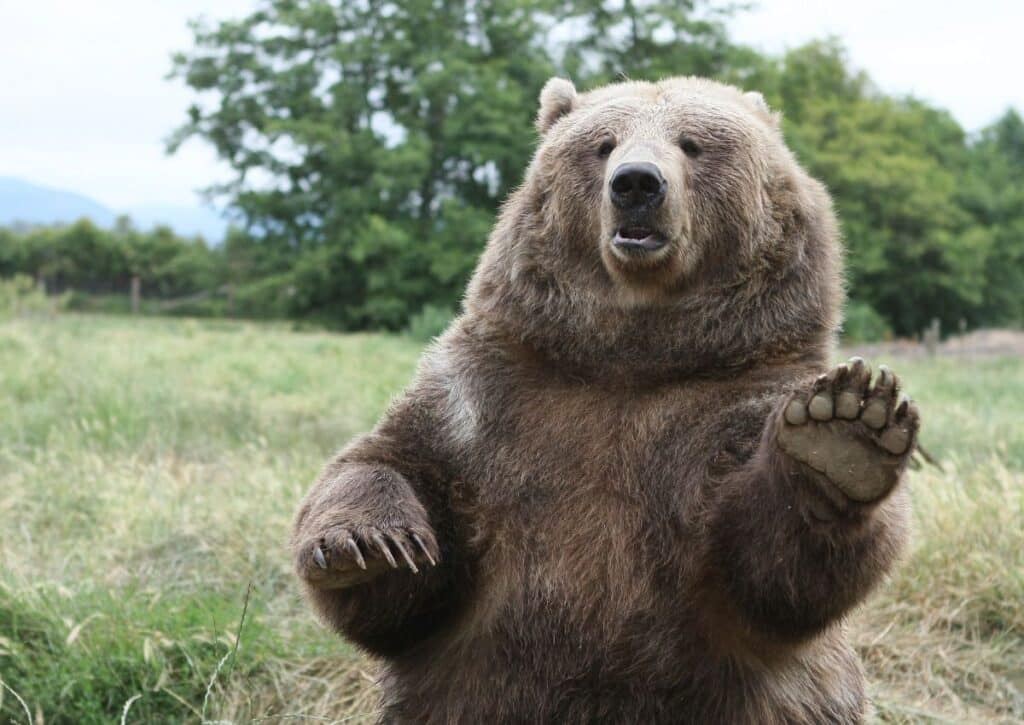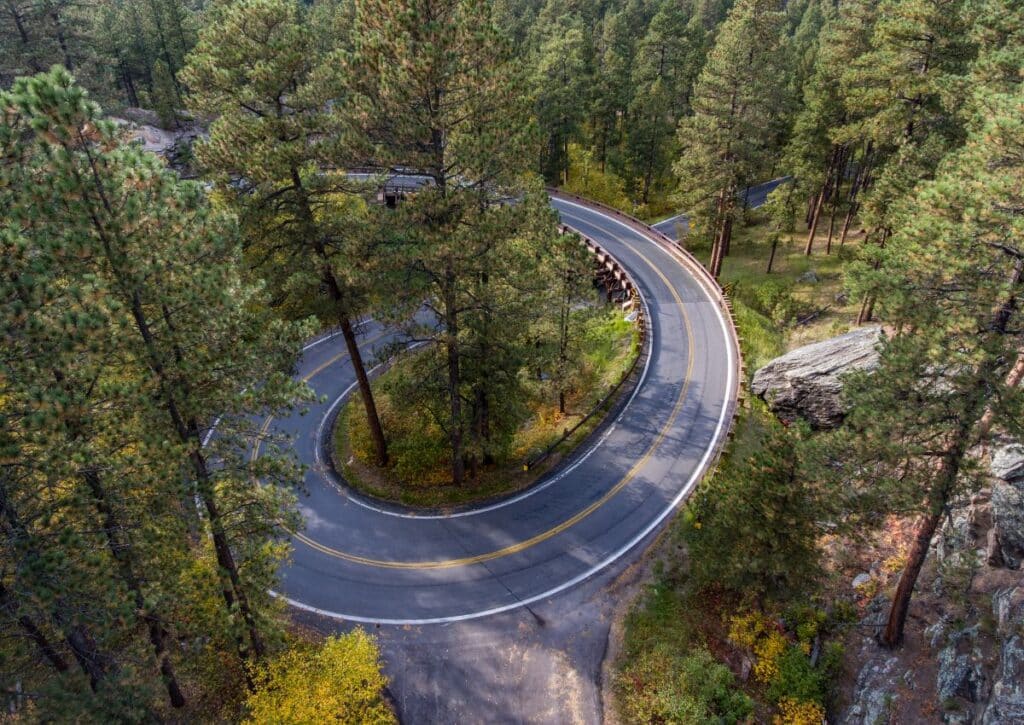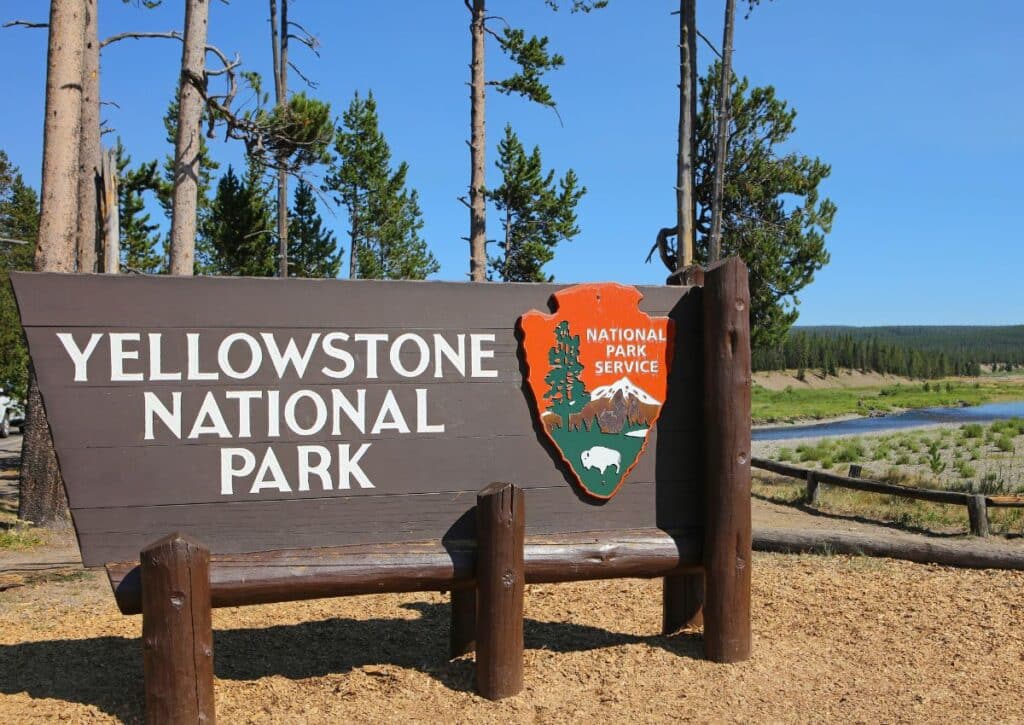Explore Yellowstone National Park Wildlife month-by-month: from bison in snow to summer birds and elk rut in fall. A comprehensive year-round guide!
Have you ever wondered what the rhythmic dance of Yellowstone National Park Wildlife looks like month-by-month? As the seasons change, so does the intricate ballet of nature in one of the world’s most famed national parks.
From the snow-capped winter months where bison trudge through thick blankets of snow, to the vibrant summer days echoing with the calls of diverse bird species, Yellowstone transforms continuously. Oh! And not to miss the elk rut in fall!
Dive into this guide and let’s embark on a monthly journey, witnessing the breathtaking displays of wildlife that Yellowstone has to offer, ensuring you never miss a beat of nature’s captivating show.
The Wildlife of Yellowstone
In the heart of North America lies a realm where nature unfurls its grandeur in the most magnificent ways – Yellowstone. A symphony of landscapes, Yellowstone becomes the perfect backdrop for some of the continent’s most iconic creatures.
The Bison, often called the American buffalo, majestically roam the plains of Yellowstone. These titans, weighing up to a ton, play a crucial role in the ecosystem, grazing and turning over the soil, ensuring the health of the grasslands.
To watch a herd of bison moving across Yellowstone’s expansive fields is to witness a living relic of North America’s rich natural history.
In the shadows of the forests lurk the Grizzly Bears, the true sovereigns of the wild. With a sense of power emanating from their very presence, they command respect.
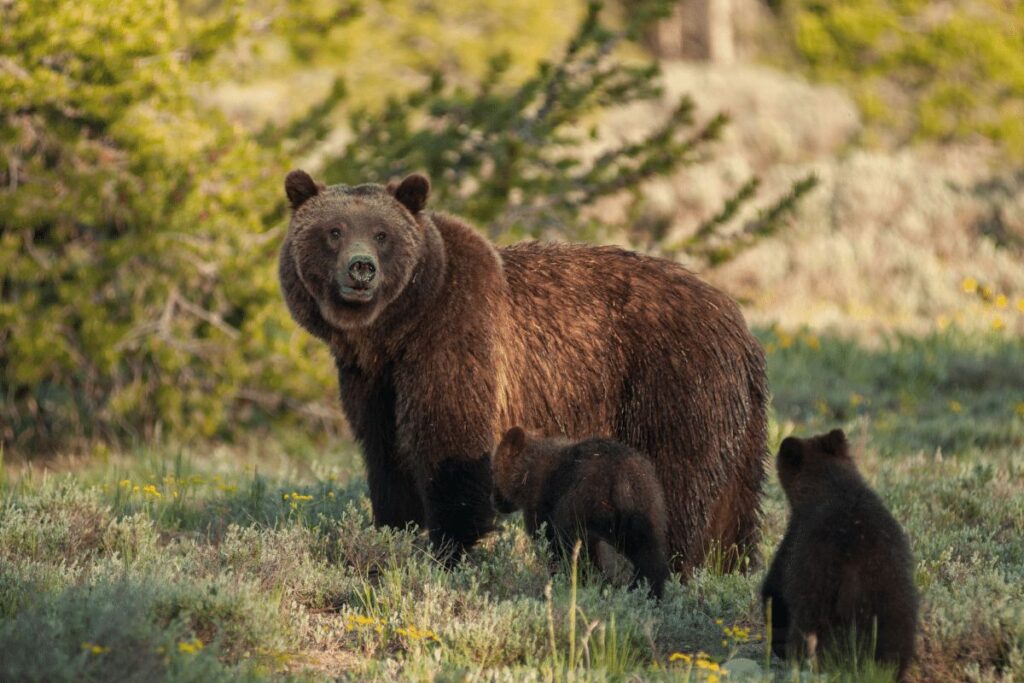
It is advisable to admire these magnificent creatures from a distance, for their strength is unparalleled and their temperament, unpredictable.
Contrasting their larger counterparts, the Black Bears of Yellowstone are more elusive. Their sleek, dark coats glisten amidst the forest canopy, often making them ghost-like apparitions amidst the dense woods. Though smaller, they remain a symbol of the wild heart of North America.
Yellowstone’s tapestry of life would be incomplete without its cunning Gray Wolves. These predators, with their hauntingly beautiful howls, orchestrate the wilderness’s music.
As pack animals, their social structures and hunting techniques are a marvel to observe, reflecting the intricacies of nature’s design.
The majestic Moose, with their towering antlers and slow, deliberate moves, often grace the waterways and wetlands of Yellowstone.
They stand as silent sentinels, often unperturbed by the world around them, making them a favorite among wildlife enthusiasts.
No less grand are the Elk, whose bugling calls resonate during the rutting season. With large herds often seen grazing or crossing the park’s many streams, they become a living testament to the park’s vitality.
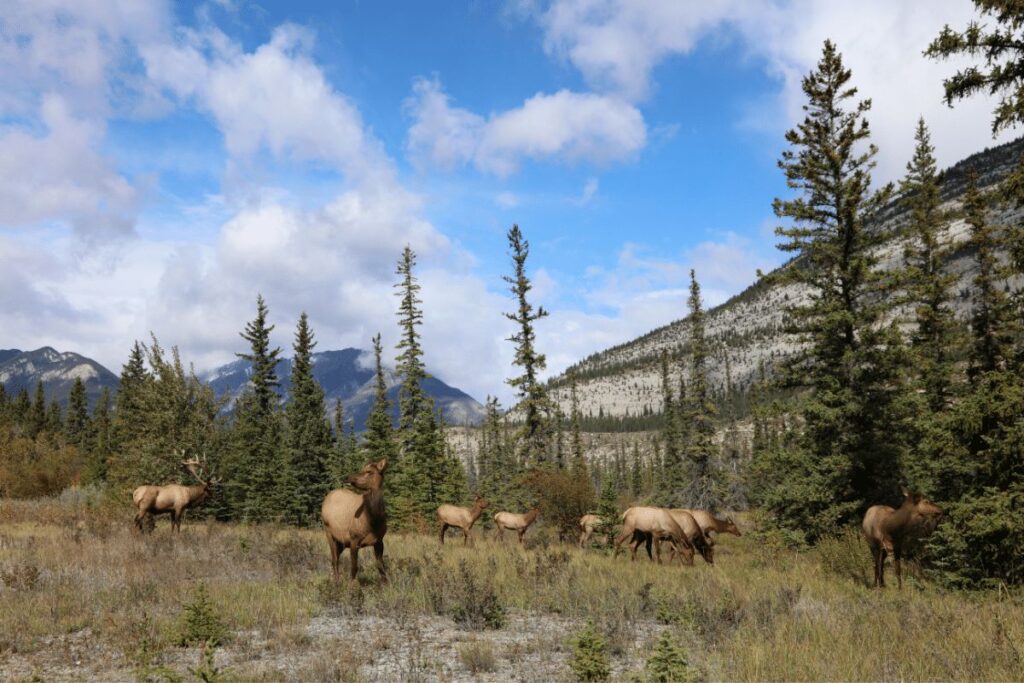
Speeding across the plains, the Pronghorn – often mistaken for antelopes – showcase nature’s design for sheer speed and agility.
Their graceful bounds can easily be seen in Yellowstone’s open spaces, as they dash, leaving behind a trail of dust.
Hidden within the rugged terrains, the elusive Cougar, or mountain lion, reigns supreme. Though sightings are rare, their very presence adds to the mystique of Yellowstone’s wilderness.
Scaling the steep cliffs and rugged mountains are the Bighorn Sheep. With their spiral horns and sure-footedness, they conquer terrains that seem almost impossible to navigate.
Their battles, especially among males during the mating season, are dramatic displays of nature’s raw power.
Soaring high above this realm, the Bald Eagle stands as a symbol of freedom. With piercing eyes and powerful wings, they scan the waters for fish, showcasing their unparalleled hunting prowess.
Often seen but sometimes overlooked, the Coyotes of Yellowstone play a vital role in the ecosystem. With their playful antics and adaptable nature, they thrive, reminding us of nature’s enduring spirit.
For those eager to witness these wonders, here are a few viewing tips:
- Dawn and dusk are often the best times to spot wildlife.
- Always maintain a safe distance. Nature is unpredictable.
- Use binoculars or spotting scopes for a closer look without disturbing the animals.
- Stay silent. The quieter you are, the more you’ll see and hear.
- Be patient. Nature doesn’t work on our schedule, but the wait is always worth it.
In the end, Yellowstone isn’t just a national park; it’s a living testament to the beauty and complexity of our natural world.
And as Sir David Attenborough would remind us, it’s our privilege and duty to cherish, respect, and protect these wonders for generations to come.
Wildlife in Different Seasons
The wonders of Yellowstone don’t simply lie in the array of wildlife it houses, but also in the rhythm by which these creatures go about their lives, dictated by the changing of seasons.
Each month and season brings a fresh tableau of scenes, different animals, and unique behaviors.
If you’ve been dreaming of a spectacle where nature’s tales unfold in real-time, Yellowstone’s monthly drama won’t disappoint.
To truly appreciate Yellowstone’s natural rhythm, one must understand the seasonal shifts and the bounties they offer.
April – Early June (Spring)
Spring is a season of awakening in Yellowstone. As the snow melts and meadows begin to green, animals emerge from their winter hideouts.
This is the prime time to watch baby animals take their first steps.
Bison calves, affectionately known as ‘red dogs’ due to their reddish-brown fur, can be seen prancing around.
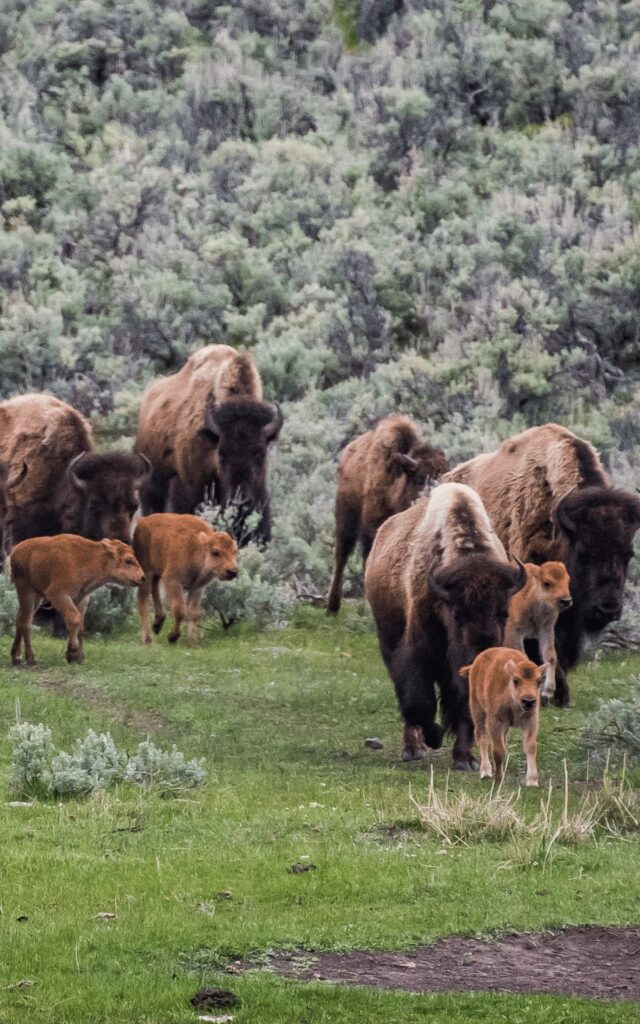
Meanwhile, bears, having just emerged from hibernation, scour the landscape for food. This is also an opportune time to witness migratory birds returning to the park.
Tip: Early mornings during spring are magical. As the mist rises, look for bears near the edges of meadows.
Mid-June – July – August (Summer)
As Yellowstone bathes in the warmth of summer, its landscapes come alive. Meadows are dotted with wildflowers, rivers gush with meltwater, and the park resounds with the calls of animals.
This period is fantastic for watching herds of elk and bison grazing, while predators like wolves and coyotes are on the move, hunting to feed their young.
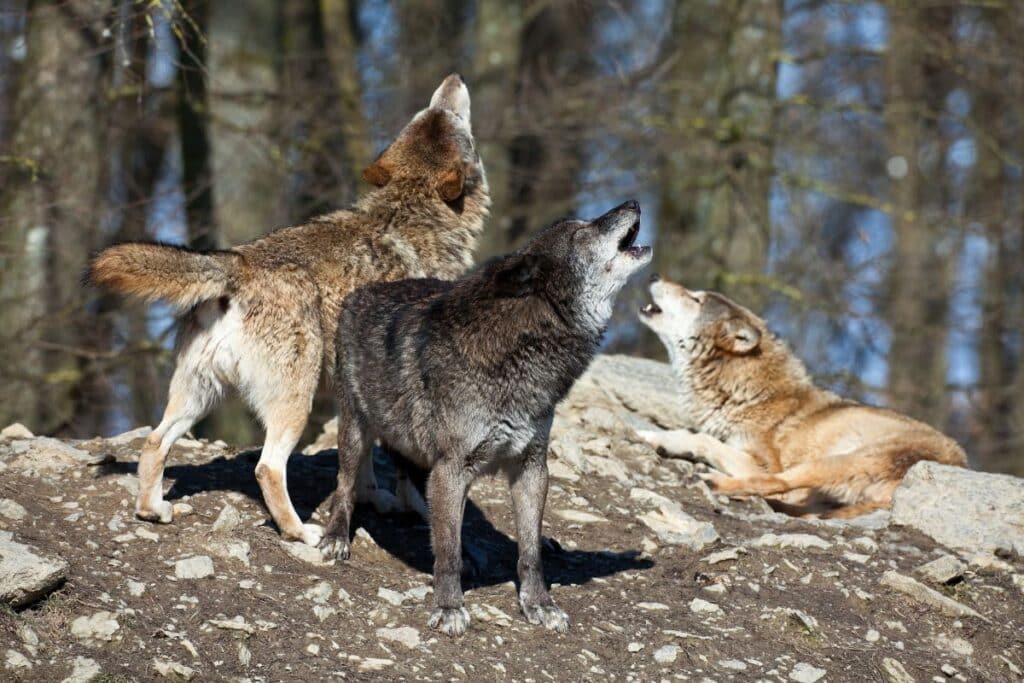
Birds, especially raptors, are active, soaring high and hunting in broad daylight.
Tip: The cool hours of dawn and dusk are particularly active times. Also, always carry a pair of binoculars. You’ll never know when you might spot a distant wolf pack or a hidden nest.
September – October (Fall)
Autumn in Yellowstone is a visual and auditory treat. As the foliage turns golden and russet, the elk’s bugling calls become the park’s defining soundtrack.
This is the mating season or the rut, where male elks compete for the attention of females.
Bison too, are particularly active. Moreover, as temperatures drop, bears increase their food intake, preparing for the long winter hibernation.
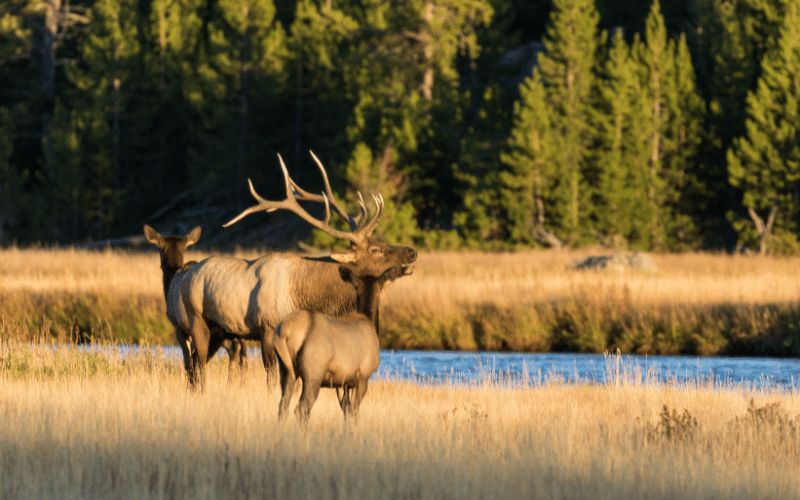
Watching a grizzly bear fishing for trout can be one of the most memorable sights.
Tip: Look for elk in open meadows during the early morning and evening. Their haunting calls are not easily forgotten.
November – March (Winter)
Winter transforms Yellowstone into a snow-laden wonderland, but it’s far from dormant. Bison, with their thick winter coats, can be seen plowing through the snow with their massive heads.
Wolves, their gray and white pelts blending with the snowy backdrop, become more visible as they hunt in packs.
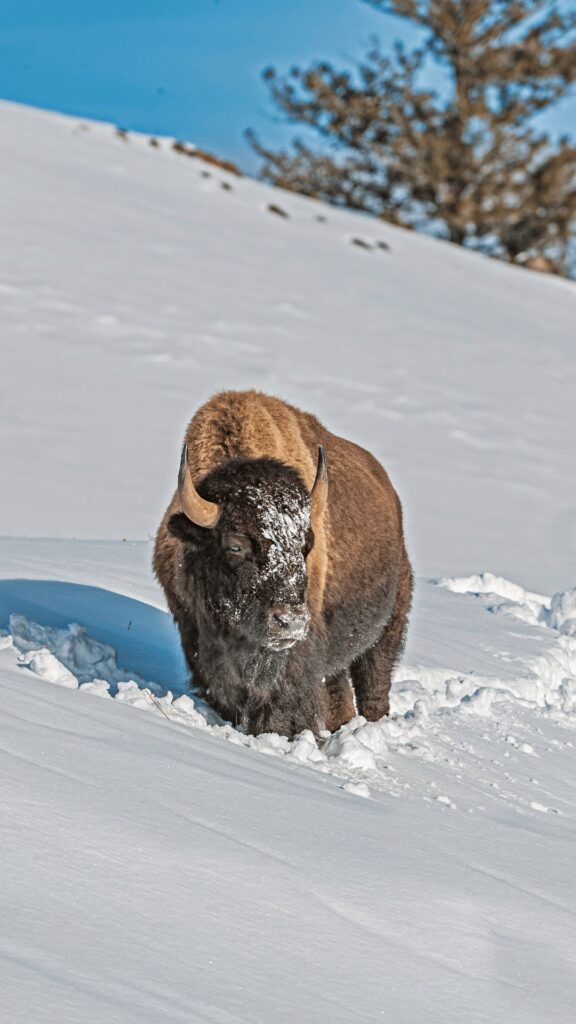
This season offers a serene beauty, with animals like the red fox, their fiery coats contrasting against the white landscapes, becoming more noticeable.
Tip: While winter offers unique sightings, always be prepared for Yellowstone’s severe cold. Warm clothing and snow boots are essential.
Also, guided winter tours can offer insights and increase your chances of wildlife sightings.
Best Time of Year to See Wildlife in Yellowstone
While every season has its unique charm, if one had to choose, late spring to early summer might be deemed the best time.
Not only is the weather pleasant, but the park teems with animals, from newborns finding their footing to predators on the prowl.
YELLOWSTONE IN WINTER
Winter in Yellowstone is nothing short of enchanting. The landscape transforms into a pristine white canvas, occasionally broken by the earthy tones of wildlife and geothermal features.
With fewer visitors, the park offers solitude and a deeper connection to nature during these cold months.
January
January marks the peak of the frigid winter. The entire park is swathed in deep snow, with temperatures often plunging below zero degrees Fahrenheit. This month witnesses one of the most captivating phenomena: the freezing of Yellowstone’s waterfalls. The cascading waters of the Lower and Upper Falls, for instance, slow down, forming delicate icicles and frosty sculptures.
The scarcity of food drives animals to the lower elevations. Wolves, with their thick winter coats, become more active during this month, often seen hunting in coordinated packs. Their haunting howls cut through the stillness, creating an eerie yet mesmerizing ambiance.
February
As winter continues its reign in February, there’s a slight increase in daylight, giving visitors a more extended window to observe the park’s wonders. One of the most iconic sights is the “snow ghost” phenomenon. Trees near geothermal areas get coated in thick layers of frost and snow, turning them into ghostly white figures.
Bison, the park’s year-round residents, can be seen using their massive heads to plow through the snow, searching for buried grass. Their resilience in such extreme cold showcases nature’s incredible adaptability.
Must-Know Yellowstone Winter Facts and Tips
- Road Access: Most park roads are closed to regular vehicles in winter. The only exception is the road from the North Entrance at Gardiner, Montana, to the Northeast Entrance at Cooke City, Montana. Snowmobiles and snowcoaches are the primary modes of winter transportation within the park.
- Thermal Features: Geothermal areas remain active, creating misty plumes against the snowy backdrop. These areas are warmer, often attracting wildlife, but the ground can be treacherous. Always stick to boardwalks and trails.
- Safety: Hypothermia and frostbite are real dangers. Dress in layers, ensure you wear moisture-wicking fabrics, and always have a waterproof outer layer.
- Wildlife Watching: While animals like bears hibernate, others such as wolves, bison, foxes, and eagles remain active. Early morning or late afternoon provides the best chances for sightings.
- Guided Tours: For a richer experience, consider taking guided snowmobile or snow coach tours. Knowledgeable guides can offer insights into Yellowstone’s winter ecology and point out hidden gems.
Winter in Yellowstone is a profound experience, marked by its stark beauty and quiet moments, offering a view of nature in its most raw and resilient form.
YELLOWSTONE IN SPRING
Spring in Yellowstone is a period of renewal, an emblematic transition from the icy grasp of winter to the verdant embrace of summer.
The once snow-covered terrains begin to thaw, revealing blossoming wildflowers and stirring wildlife, all set against the backdrop of gushing rivers and revitalized geothermal wonders.
March
As the calendar turns to March, the days start to grow longer, heralding the early signs of spring. Yet, vestiges of winter remain, with snowdrifts still occupying shadowed crevices and northern-facing slopes.
At this juncture, migratory birds like the mountain bluebird and the American robin begin their return, adding a splash of color and melody to the landscapes.
Waterways, though still partially frozen, start to show signs of movement. The park’s numerous geysers, including the iconic Old Faithful, gain renewed vigor with the melting snow feeding the underground chambers.
April
By April, Yellowstone truly begins its transformation. The valley floors start to clear of snow, presenting greener pastures daily.
This is a crucial period for the park’s herbivores, such as elk and bison, as they descend to these lowlands seeking fresh grazing grounds.
Consequently, predators like wolves and bears, fresh from their winter slumber, become more active, trailing these herbivores.
One cannot overlook the spectacular bear sightings in April.
Both grizzly and black bears, having emerged from hibernation, can be seen scouring the landscape, often with their playful cubs in tow.
May
May witnesses Yellowstone in full spring bloom. Wildflowers, including the vibrant lupines and the delicate shooting stars, carpet the meadows.
Rivers run high and fast from snowmelt, and the park’s waterfalls, like the Grand Canyon of Yellowstone, roar to life in a magnificent display.
As the temperatures rise, the park becomes a nursery. Bison calves, often termed ‘red dogs’ because of their rust-colored fur, start making their appearances.
Elk, pronghorn, and moose too welcome their young, adding to the park’s bustling springtime tableau.
Meet Yellowstone’s Spring Babies
Nothing epitomizes spring in Yellowstone like the sight of its newest residents taking their first steps in the world.
From the spindly-legged elk calves hiding in tall grasses to the curious moose young exploring the wetlands, each sighting is a heartwarming spectacle.
Of particular note are the bear cubs. Their antics, whether it’s climbing trees or play-fighting, offer delightful viewing opportunities.
With young ones around, it’s vital for visitors to exercise extra caution. Mother animals, especially bears, can be exceptionally protective, making it essential to maintain a safe distance and avoid any disturbances.
In essence, spring in Yellowstone is an evocative blend of rebirth and rejuvenation, offering visitors an unparalleled experience of nature’s grand theater.
YELLOWSTONE IN SUMMER
Yellowstone in summer is a symphony of life. The expansive wilderness comes alive with vibrant hues, echoing birdcalls, and the delicate dance of flora and fauna.
The warm months offer an explosion of activity, from bustling herds of bison to elusive predators on the prowl.
This season, with its extended daylight and optimal weather, remains the park’s peak time for visitors.
June
As June dawns, Yellowstone’s high-altitude regions finally shed their snowy mantle. Wildflower meadows burst into a riot of colors, with Indian paintbrush, fireweed, and forget-me-nots painting a vivid landscape.
The park’s lakes and ponds, reflecting the cerulean blue skies, are abuzz with activities — cutthroat trouts leaping in waters and ospreys soaring overhead searching for prey.
This month, many trails, especially those leading to Yellowstone’s iconic spots like the Grand Prismatic Spring, become more accessible.
This geothermal wonder, with its radiant colors, is a sight to behold in the gleaming summer sun.
July
July in Yellowstone is nature at its peak. Grassy plains are dotted with bison, often causing the delightful ‘bison jams’ as these majestic creatures decide to amble across the roads.
The heat of the month also means more activity at night, with nocturnal creatures like owls and bats making their presence felt.
One mustn’t forget the serenades of the amphibians. Frogs and toads, especially in the wetter regions of the park, add their croaks and calls to the soundscape, marking the full swing of summer.
August
As August approaches, there’s a subtle shift. The park, though still in summer’s embrace, starts preparing for the oncoming autumn. Berries, a vital food source, ripen and attract a plethora of wildlife, including bears, eagerly fattening up for winter.
Forest canopies resonate with the calls of migratory birds beginning their southward journeys.
August nights, especially in the park’s vast dark sky areas, offer brilliant stargazing opportunities, with the Perseid meteor shower being a highlight.
10 Tips for Summer Wildlife Viewing in Yellowstone:
- Dawn & Dusk: These are prime wildlife viewing times. Creatures are most active during the cooler hours.
- Use Binoculars: A good pair of binoculars or a spotting scope enhances viewing while ensuring you maintain a safe distance.
- Stay on Designated Paths: Always stick to the marked trails and viewing areas.
- Maintain Distance: Never approach wildlife. Not only is it dangerous, but it also stresses the animals.
- Drive Slowly: Speeding can lead to road accidents involving animals.
- Attend Ranger Programs: Park rangers often host programs providing insights into wildlife habits and habitats.
- Stay Quiet: Noise can disturb and deter wildlife.
- Respect ‘Bison Jams’: Wait patiently if bison or other animals are on the road. They have the right of way.
- Stay Informed: Knowledge about animal behavior can enhance your viewing experience.
- Practice Leave No Trace: Ensure you leave no garbage or food scraps behind.
In summer, Yellowstone thrives, presenting a majestic tableau of nature in its full glory, an experience that lingers in the memories of its countless visitors.
YELLOWSTONE IN FALL
Yellowstone in fall is a masterpiece of nature’s artistry. The park is draped in an intricate tapestry of russet reds, fiery oranges, and deep yellows, heralding a season of change.
As temperatures dip, the park undergoes a remarkable metamorphosis — from its wildlife patterns to its mesmerizing vistas.
September
September brings with it a perceptible shift in Yellowstone. The once-green deciduous trees transition into shades of gold and amber, especially the aspens and cottonwoods.
The park’s expansive meadows are painted in the warm hues of autumnal wildflowers like goldenrods and asters.
Wildlife too adjusts to the changing season. Bull elks, with their magnificent antlers, engage in vocal displays called bugling — a hauntingly beautiful sound echoing through the valleys.
This ritual, aimed at attracting females and warding off rivals, becomes a key attraction for visitors.
Moreover, bear sightings become more frequent.
With the onset of the hibernation period nearing, both grizzly and black bears scour extensively for food, gorging on berries, fish, and small mammals to build up fat reserves.
October
By October, a crisp chill permeates the air. Snow dusts the higher elevations, rendering the park’s peaks and plateaus into a shimmering white.
Many water bodies start displaying thin layers of ice around their edges, signaling the approaching winter.
Birdwatchers are in for a treat. October is the peak of bird migration in Yellowstone. Raptors, especially eagles and hawks, can be spotted in higher numbers, riding the thermal currents and heading south.
The park’s herds, especially the bison, start moving to lower elevations in search of food. Their slow, deliberate migration against the backdrop of fall colors creates a picture-perfect scene.
November
November is the preamble to Yellowstone’s winter. The days grow shorter and a hush descends on the park. Most of the deciduous trees have shed their leaves, standing stark against the gradually whitening landscape. Snowfall becomes more regular, covering meadows, forests, and paths in a thick white blanket.
Yet, life perseveres. Packs of wolves become more visible, traversing the snow in search of prey. Their howls, echoing in the silent expanse, add to the ethereal beauty of the season.
Lakes and rivers freeze over progressively, with only the geothermal areas like geysers and hot springs remaining ice-free, creating misty plumes that stand out against the frigid surroundings.
In all its phases, Yellowstone in the fall is an enchanting mix of vibrant landscapes and stirring wildlife activities, encapsulating the transient beauty of nature preparing for the harshest of seasons.
The Elk Rut in fall
In this season, Yellowstone witnesses the dramatic spectacle of the elk rut. As the chill sets in, mature bull elks, adorned with massive antlers, engage in a compelling display of power and allure.
Their haunting bugles, a mix of deep resonant notes and high-pitched screams, echo through the park, signaling a challenge to rivals and a call to potential mates.
Fierce battles ensue as males spar, locking antlers in tests of strength to establish dominance and secure breeding rights.
Amidst the backdrop of fall’s vibrant colors, this ritualistic dance of nature offers a mesmerizing insight into the wild dynamics of Yellowstone.
Yellowstone in December
Yellowstone in December is a realm of profound stillness and beauty. As winter firmly establishes its grip, snow blankets the vast landscapes, turning the park into a shimmering wonderland.
The trees, laden with powdery snow, stand as silent sentinels against the icy blue sky. Geothermal features, like geysers and hot springs, become even more striking.
Their steamy eruptions and warm waters cut through the cold, creating misty plumes visible from miles away.
Most roads close, but determined visitors can explore via snowmobiles or guided snow-coach tours.
Wildlife like bison, with their thick winter coats, can be seen plowing through the deep snow, a testament to nature’s resilience in the face of harsh climates.
In this hushed month, the low angle of the sun casts a soft, golden hue, contrasting starkly with the crisp white expanses. Lakes and rivers, which once teemed with activity, now lie frozen, their surfaces reflecting the subdued winter light.
However, beneath the ice, life persists as cutthroat trouts and other aquatic species adapt to the cooler temperatures.
December is also a time when Yellowstone’s carnivores, like wolves and coyotes, become more active and visible against the snow.
Their tracks create intricate patterns on the pristine ground, telling stories of hunts and territorial patrols. The wolves, in particular, thrive in this season, using their keen senses to locate prey beneath the snow.
For the avid birdwatcher, Yellowstone offers sights of hardy bird species that brave the winter.
Bald eagles can be seen perched high on treetops, scouring for fish in open water patches, while smaller birds like chickadees and nuthatches flit about, their cheerful calls breaking the winter silence.
Visitors to Yellowstone in December often find solace in the park’s solitude. Popular spots, which buzzed with tourists in summer, now exude a serene ambiance.
For those willing to brave the cold, guided snowshoe and cross-country ski trips offer an intimate experience of the park’s winter magic.
Camping becomes a pursuit for the truly adventurous. With nighttime temperatures plunging, the clear skies showcase brilliant constellations, and if one is fortunate, the ethereal dance of the Northern Lights.
Yellowstone in December unveils a realm where nature, in its harshest form, showcases a serene yet resilient side, reminding visitors of the enduring beauty and tenacity of the natural world.
Also read: 30+ BEST THINGS TO DO IN YELLOWSTONE NATIONAL PARK (ALL INCLUSIVE GUIDES TRIPS!)
Top Spots to Witness the Majestic Wildlife
Yellowstone, an expansive tapestry of nature, is woven intricately with mountains, forests, rivers, and geysers.
It’s here that one truly understands the grandeur of our natural world.
But for many, it’s the park’s wildlife that truly captures the imagination, offering a tantalizing glimpse into North America’s rich biodiversity.
Where to See Wildlife in Yellowstone
Yellowstone’s vast landscapes, ranging from alpine meadows to dense forests and gushing rivers, serve as a refuge for an array of creatures.
Yet, amidst this sprawling wilderness, there are certain spots which, over the years, have gained a reputation as the park’s epicenters of wildlife activity.
To stand in these places is to feel as if one has stepped into nature’s own theater, awaiting the spectacle of life to unfold.
3 Best Spots for Wildlife Viewing
While Yellowstone has numerous places offering glimpses of its famed fauna, there are three locales that stand out, each unique in its topography, each resonating with tales of nature’s undying spirit.
Lamar Valley
The Lamar Valley, often hailed as the ‘Serengeti of North America,’ stretches out as an expansive meadow, dotted with groves of trees and dissected by the meandering Lamar River.
As dawn breaks, the first rays of the sun illuminate the valley in a golden hue. It’s in this magical light that one might spot the grey silhouette of wolves on the prowl, their haunting howls echoing across the distance.
This valley, with its open vistas, is a haven for herds of bison. These magnificent beasts, symbols of the American wilderness, graze lazily, their bulky forms casting long shadows on the grass.
Pronghorns, the continent’s fastest land animals, can often be seen sprinting across the plains, their graceful movements contrasting with the deliberate, powerful gait of the bison.
But the Lamar Valley is not just about its mammals. Birds of prey, like the golden eagle and red-tailed hawk, circle the skies, their keen eyes searching for a meal. Along the riverbanks, otters playfully slide into the water, their antics a joy to behold.
Hayden Valley
Hayden Valley, cradled between Yellowstone Lake and the Yellowstone River, is a mix of marshlands, meadows, and pine forests.
This mosaic of habitats makes it a hotspot for wildlife diversity. As you traverse the valley, the resonant bugling of male elks might greet you, especially during the fall rutting season.
These majestic creatures, with their towering antlers, are a sight to behold as they parade, seeking the attention of their female counterparts.
Yet, it’s perhaps the valley’s grizzly bears that most captivate the imagination. Often seen in the early mornings or late evenings, these apex predators traverse the meadows, their powerful forms a testament to nature’s raw strength.
For the fortunate observer, a mother grizzly with her playful cubs in tow offers an unforgettable spectacle, a gentle reminder of the tender bonds that exist even in the wild.
Mammoth Hot Springs
The landscape around Mammoth Hot Springs is a stark departure from the verdant valleys. Here, steaming terraces of carbonate, shaped over millennia, present a surreal backdrop. But look closer, and this geothermal wonder doubles as a stage for nature’s drama.
Bighorn sheep, perfectly adapted to the rugged terrain, navigate the rocky outcrops with astonishing agility. Their curled horns, a symbol of their age and status, glint in the sunlight as they graze on the sparse vegetation.
The springs, with their warm waters, also attract a myriad of birds, especially in the colder months.
The mountain bluebird, with its azure plumage, flits about, adding a splash of color to the otherwise earthen tones of the springs.
As night descends, the elusive cougar might make an appearance, its stealthy movements a whisper against the backdrop of gurgling waters and hissing steam.
Also Read: 10 THINGS TO KNOW BEFORE GOING TO YELLOWSTONE NATIONAL PARK
Conclusion
Journey through the seasons, from the silent majesty of snow-clad winters to the bursting vibrancy of spring’s new life, the lazy warmth of summer meadows, and the kaleidoscope of autumn colors.
We’ve pinpointed the prime locales, like the expansive Lamar Valley and the geothermal wonder of Mammoth Hot Springs, where nature’s drama unfolds in breathtaking detail. Whether you’re a seasoned naturalist or a curious wanderer, this guide beckons you to immerse yourself in Yellowstone’s timeless dance of life.
Every page is an invitation, every month a new act in the grand performance. Dive in, and let Yellowstone’s wildlife narrative enrapture your senses.

